All the speakers and sessions hosts of ASEAN Fabrics Symposium 2025
In the morning heading out for the second day of the symposium, we were admiring each others looks for the day, realising we were rocking all the same green & purplish pink colour. How fun to be colour co-ordinated without making plans, it was meant to be.
Batik shopping with Suzanne Lim in Kuala Lumpur,
selfie with batikshop Antakesuma owner
My last and first visit to Kuala Lumpur in Malaysia was in 2022 I stopped by before going to Java, visiting John Ang’s ‘Splendours of Malay World Textiles’ exhibition & to see the Islamic Art Museum.
When planning my 7th journey to Batik, how is it the 7th time suddenly being in Southeast Asia!, I reached out to John Ang, hoping to visit him. He told me about the textiles symposium organised by Muzium Tekstil Negara (Textile Museum of Kuala Lumpur). I reached out to the organizers, and some weeks later got the news that I could not only attend, but speak too.
The symposium was organised to take place with the ASEAN program, that was why our theme was ‘Textile sustainability: Tradition towards transformation’.
Some of the speakers at the Lao ASEAN & IASSRT textile symposium gave a talk here too, like me, so it was nice to have this small reunion. It was a good topic to dive into and I was happy to see & hear most shared their critical thoughts, realistic suggestions & empowering wishes for the future of the textile crafts they were representing. I had to honour to go last, so lets highlights some talks before me.
First talk of the symposium by Thweep Rittinaphakorn
After several opening speeches, the first official presenter was Thweep Rittinaphakorn, or as we say Ake. The in Bangkok based Ake has been researching Myanmar traditional wear for a while collecting sarong, manuscript wrappers, old photographs and many more objects. Last year got to visit him and see part of it. Ake shared on the weavers of the traditional wave like pattern and how current makers have not only a difficult time because of the political unrest (read cival war) but also because of the recent earthquake on 28 March, not only killing & hurting many people, but also destroy their homes completely. It was good Ake shared the images, images people in Myanmar cannot make public themselves to the outside world.
“If we can all inspire five young people to start making again,
we are doing a good job for the future”
~ Linda McIntosh
Linda McIntosh who organised the ASEAN Textile symposium last year in Laos shared on the different communities in Laos and their traditional wear.
She had a suggestion that might benefit makers in the future. At the moment most materials for the textile making industry are either bought abroad or from others. There is less interest in growing textile crops. If the government would invest in farmers growing textile crops & sell these to the makers, as a textile bank as you will, it would be better for the economy and provides more protection to the makers.
Talk by Bernard Joseph Guerrero
Talk by Aroonprapai Rojanachotikul
Q&A after the session, also people online watching could send in questions
My talk, Future of Batik
Can the past help us with preserving Batik for the future? And how can the past helps us? There are many developments that happened throughout batik history. Especially in the 19th century mostly due to colonial influence. In the 19th century the interest for Batik from Europe grew. Museums started collecting batiks, displaying it during Colonial Exhibitions and people, mostly white Dutch men, started researching batik. The growing interest in batik was mainly because it was seen as an interesting colonial business opportunity. Not to invest in actual batik, but to market European made products like synthetic dyes and machine woven cotton to batikmakers and also to sell (machinemade) imitations of batik in Southeast-Asia itself. At the same time batik was changed and put under pressure, it was collected and documented by Dutch researchers, museums and the industries that made the imitations. These kept collections and gathered data in the Netherlands on batik can be used now for good. Besides providing us with (her)stories to appreciate the resilience of batik even more, current makers can use it to unravel traditional, natural dye recipes. Find ways to create batik in a safer, more sustainable way.
Bolk will share more on the stories of the past, what we can learn from it and the work she does together with makers, researchers and other batik fans, such as improving access to collections, organising events to promote and showcase batik and the batikmakers, sharing stories and simply by just wearing real batik daily. To preserve batik we should not just focus on what is kept in museums and private collections, but also insure new batik is still being made.
When I have special moments in my life, I try to dress appropriate for it. Since my life is Batik, it means I have a great excuse to get new outfits. For the ASEAN Fabrics symposium I wanted to dress of course in Malaysian Batik. I reached out to Nysakapas if it was possible to have an outfit made before the event, and I was so happy when she said yes. In 2022 during my visit to Terengganu in Malaysia, we also stopped by the Nysakapas shop housed in a beautiful traditional house. I loved the colours of her items and the use of her logo, a flower, in her items. So when I got to pick a fabric for my look I wanted this to be included to. I picked this nice green Batik Terap with the flower in a lighter green and another pattern in lilac.
The dress design was brand new with a nice pleated detail in the back. For me it look very traditional and similar to what many ladies were wearing during the symposium, but I was complimented a lot on my modern look. So Nysa all compliments of course to you!
At the gallery of Bank Negara Malaysia
After 1,5 days of talks, we got to visit two museums. First the gallery of Bank Negara Malaysia that hosted the symposium. There were no textiles on display, but works inspired by textile. They have a collection of Batik paintings, that I would love to see next time. The exhibition featured artists that are also authors, or authors that are also artists. So Artworks & Books, perfect!
Batik Terap display at Muzium Tekstil
Colouring of Batik Tulis display at Muzium Tekstil
At Muzium Tekstil my jetlag was in full force and I think our group of speakers was running a little low on energy, but we got to see the displays of Batik, Songket, Limar and more. I am curious to their research/library place, so next time will revisit to do a study morning!
Selection of imitations (old and newer) found in John Ang's collection
Next to the Fabrics Symposium, I got to give three more talks. When chatting with John, he suggested I gave a talk while staying at his home. I gave him three topics to choose from, but he thought all three would be interesting, so planned 3 talks. I had no idea on the audience that might be interested, but John insured me, next to Malay Batik, there will be plenty of interest for Indonesian batik & Dutch colonial history.
And to my surprise all three session were fully booked. In the nice ambience of John Ang’s home, I got to give the talks. First talk was on Saturday 12 July. Luckily my jetlag was a good as gone, but I needed to prepare the talks still since I had no time before my travels. Also I got to handpick from John’s vast collection. First talk on imitations provided me with marvelous pieces that we hardly have in Dutch collection. Like the printed imitation head cloths made for the Sumatran market, similar in design to what the Dutch cotton company Ankersmit made and are very likely made by them. Also John has newer imitations, even Wax Prints that I bought for him & gifted over the years. Also this time I brought a new piece, a big bouquet in Wax Print with silver appliqué.
Showing iket kepala, an imitation from John Ang's collection.
Probably made in the Netherlands for the Sumatran market
Showing new Vlisco ABC next to on the slide old ABC by Ankersmit
It was so nice to meet the textile community in Kuala Lumpur, of course already at the symposium, but because this talk was in the weekend, the working textile fans/collectors/scholars/colleagues/designers could join. To my surprise, as I was also told in the days prior, the textile community was do happy I finally came & did program! I promise I will be back & for sure organise more!
Display on batiks by the former queen
On Sunday I had a free day. After asking around what the visit that has Batik, I got the tip to go to Kompleks Kraf. This compound on Malaysian crafts houses a small museum, Muzium Kraft, shops and workshops spaces. It also does activities and performances, but not on Sundays.
I first headed to the Muzium Kraf. When entering all the craftspeople who received an award are highlighted. Either with the actual craft they made, or just their bio & photo of the work. The tradition, I was told later, is that you cannot be awarded until you are 40 year in the business of your craft. I understand it takes time to master a craft, but the reality is that the craftspeople welcoming you in this museum are mostly very old, and not with us anymore. My first thought was, why they show craft as being dead...?
Display of craft awardees at Muzium Kraf
If the museum is meant as a celebration, it was for me odd that the journey of these craftspeople was not shared. No photos of when they started, of making their work or on their students. The many dates on their passing away and no clear sign of how the craft is continued gave me a heavy heart.
Upstairs the crafts are shown in diorama style, luckily the large size figures are just a simplistic version and not try to be realistic. There is a display on Batik Terap/Blok with a focus on makers from Kelantan. I only been to Terangganu, which I enjoyed, not sure why there are no masters featured from there. The display also has an interactive element showing you the removal of the wax. It brought back many memories of my previous stay in Malaysia.
Diorama on Batik Terap
Book 'Batik Tulis Bengkel Pengurusan dan kewangan'
In the museum they also have a corner with books to browse through. It was nice to see some books on Malaysian Batik I didn’t see before. Especially loved the ikea like manuals to set-up a batikworkshop, from building, to wax pot, to hanging rack. All including measurements.
After the museum, I explorer the shops. The shops have many different crafts, but batiks is I think the best represented. You can find full cloths, by per meter, all kinds of readymade clothing & other items.
Posing with the Batik I bought with the owner of Antakesuma at Pasar Seni
In the afternoon I met with Suzanne Lim. Big fan of her instagram @runaroundsuz_vtg where she shares her love for vintage/historical dress, both Western & Southeast Asian style, her interest in the past with visits to antique shop, places & buildings and much more.
Suzanne was so kind to show me around Chinatown & Pasar Seni. In Pasar Seni, a building from the 1920’s, but with an older history, you can find all sorts of stores with mostly touristic items. Also many many many will only have printed textiles with a batik motif. These might be sold under the name ‘Batik’, but are just machineprinted.
There are however two stores with modern handmade Malaysian batik. The first is in between the other shops, Antakesuma, and from first glance might look like the others selling fakes. But this shop-owner had many hand-blokprinted (Batik Blok/Cap) & handdrawn batiks (Batik Tulis). She orders the pieces herself and when chatting about it, she started showing us videos of the making process. She especially gets the older designs from the 1960’s-1970’s, these ones might be seen as the closest related to Indonesian batik. They have a more classic looking kapala in black and a flower design in the badan. They remind me of the old pieces from Tanah Abang in Jakarta from the 19th century. I picked one of these classic pieces, since I didn’t get on when I actual was in Terangganu.
The late Tun Endon binti Mahmood Ambak om cover of her own Batik magazine, Batik Guild
Next one is Galeri Seni Endon, the shop of the late Tun Endon binti Mahmood Ambak (1940 – 2005) was the first wife of the 5th Prime Minister of Malaysia, Tun Abdullah Ahmad Badawi. She was a strong supporter of arts and crafts, especially the batik industry. Her love for Malaysian heritage is evident in her private collection of traditional costumes, artefacts and decorative household items. The Piala Seri Endon batik design competition held every year in her honour since 2003.
I own a book on kebaya by her, The Nyonya Kebaya: A Century of Straits Chinese Costumes (2002) but didn’t looked up the author before.
She set up the Batik Guild to strengthen the local industry by gathering them under one umbrella. She injected new ambition into the rural batik industry encouraging them to be involved in the exciting new changes that she was creating for batik. (Source: World Batik Council)
The store features her legacy in fashion, but also has the magazines of the Batik Guild. Bought one with a nice cover of a hand drawing wax with the Malaysian waxpen, would love to read all. Anyone knows if the magazine is still being made?
Butterfly outside of the butterfly garden
On Monday before giving my second talk, I went to the Botanic garden. I wanted to get some inspiration for the batik workshop I was doing the next day, and be outside. I started at the butterfly garden. On the parkinglot, outside, I saw the biggest butterfly! Insight I enjoyed the small ones that I never saw before and the nice flower. Enough inspiration for my batik design.
Making an selection of batiks with an European influence visible
in their style or design from John Ang's collection
Talk on European Influence, showing batik with soldiers
Second talk at John Ang was on European influence in Batik. Made a selection of the batiks John has with a visible style in design & motifs influenced by Europe. Most are from makers that followed after the period it was introduced, showing how the motifs were adapted throughout Java and made their way also to the Malay market.
I also showed some pieces I brought that will be on display at aNERDgallery in Singapore from 22 August till end of September. Mark your agenda and keep an eye out for our program!
Making a batik totebag at Teja Studio
Tuesday morning I got to make a batik at Teja Studio before my last talk in Kuala Lumpur on 15 July. I have been following them online for a while now.
Teja studio started in 2018 as a place for workshops on batik drawing & batik painting. During the pandemic their DIY packages become really populair.
I always enjoy seeing their instagram post and the amazing view from their studio. So very happy I finally got to go and make a totebag.
To my surprise, they were familiair with my work and kinda puzzled why I did a workshop, since I know batik already. But I told them, you always learn something new and I enjoy making something always. Got to try now the Malaysian canting, do the watercolour effect with the dyes and even added sugar for a extra effect. The drawing I based on the flowers & insects I spotted during my visit to the Butterfly garden the day before.
Thank you Teja Studio for welcoming me, looking forward meeting in the future for more batik talk!
Posing with the Teja Studio Team
In the afternoon I gave my last talk, in this session I shared current developments in Batik made on Java & Terengganu in Malaysia. I focussed on the makers of the batiks and their wishes, worries & newly made designs. After two talks reflecting on the (colonial) past, it was great to wrap up the sessions with a look at the future of Batik!
Thank you Muzium Tekstil and all organisers for the invite to the ASEAN Fabrics Symposium!
Thank you John Ang & your team for hosting me!
Thank you to everyone who came to say hi, shared a meal with me or just simply started following my journey to Batik!
Will be two months on the road. Will try to update here as much as possible, but do check my social media & website too!










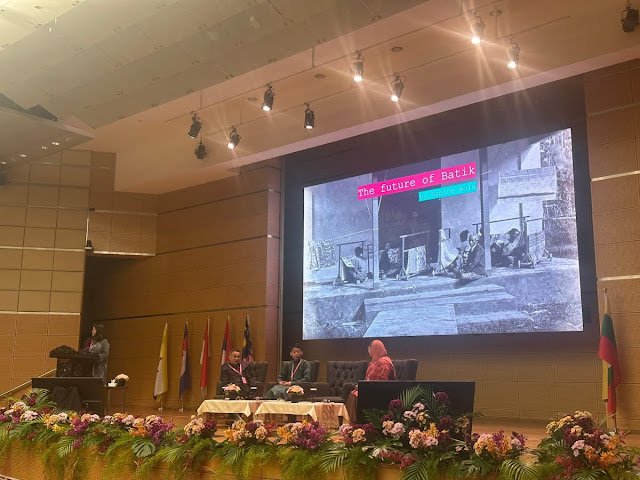










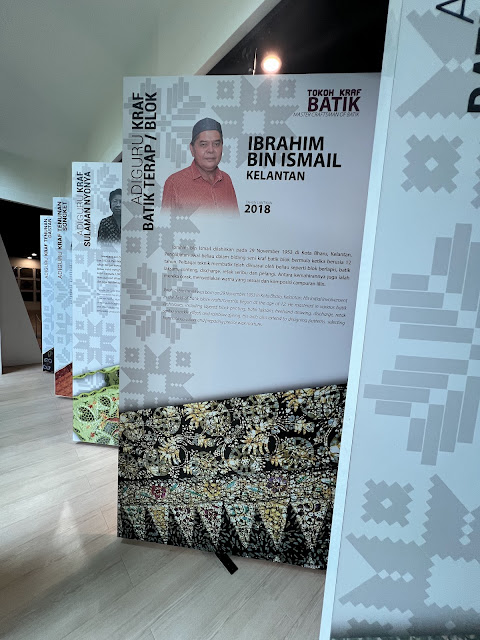
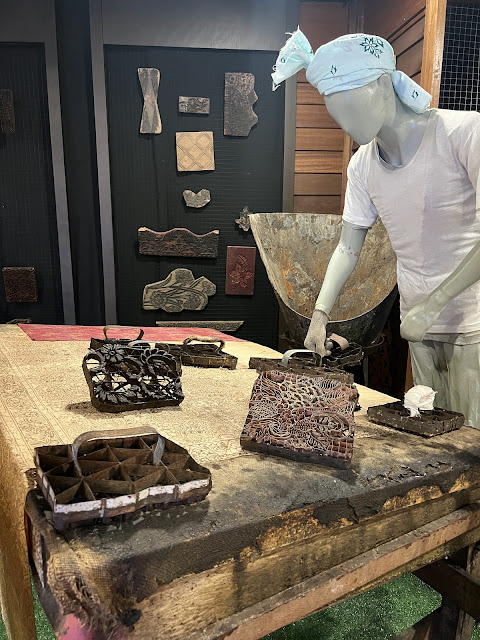
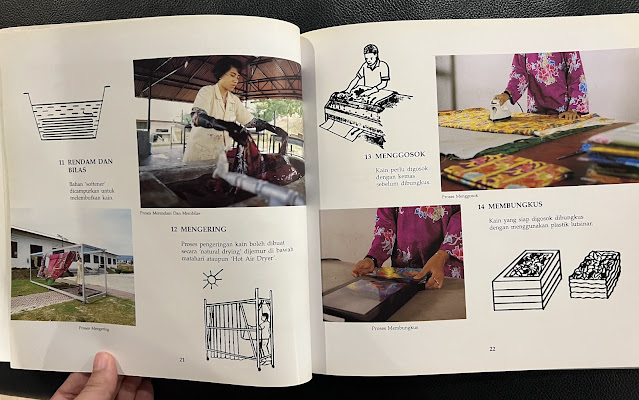






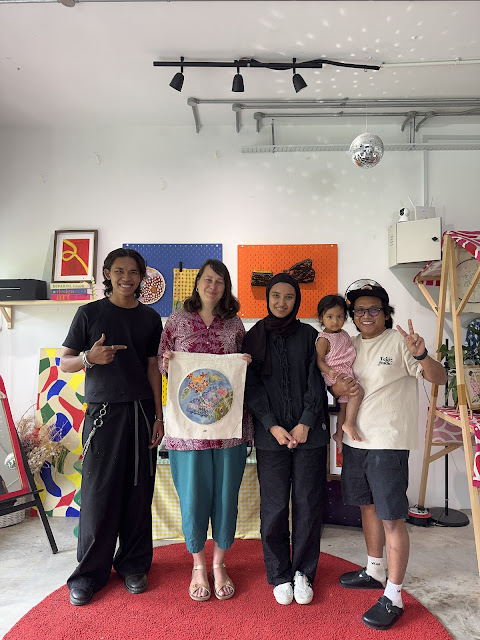
No comments:
Post a Comment